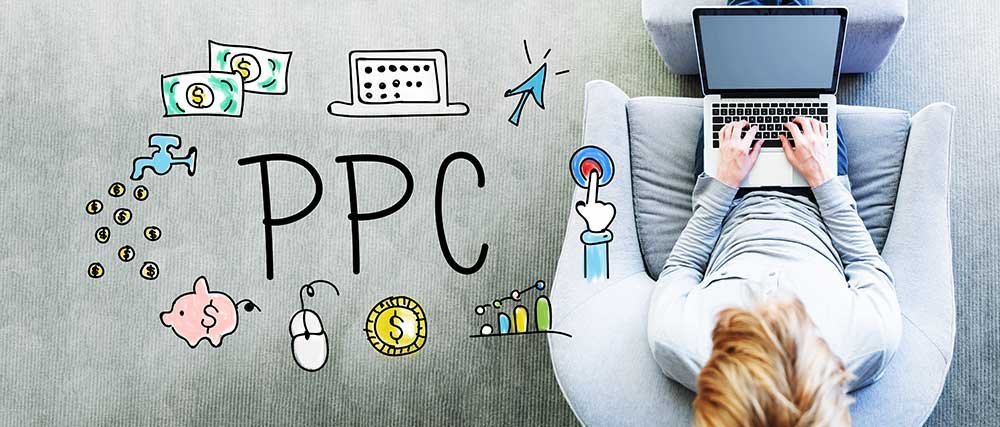#7) Use PPC Advertising to Help Customers Find You
Although we’ve already covered the importance of local search engine optimization, it’s important to point out there is another way you can grab local buyers from Google. And, you can use it instantly and inexpensively.
The technique we are referring to, of course, is pay-per-click advertising. It involves using paid placement on search engine listings and social media feeds to get your offers in front of targeted buyers.
On search engines, you choose your audience based on the keywords they are searching. On social media, it’s all about demographics and stated interests. What small business owners should realize about both, however, is that Google, Facebook, and other platforms give you the ability to restrict ad viewership by location. In other words, you can choose to target only potential customers who live or work in your neighborhood.
This is crucial because it lets you lower costs and improve response rates in a dramatic way. Many business owners struggle with PPC because their campaigns and budgets get out of control quickly. They find themselves spending head-to-head against dozens of other entrepreneurs and marketing managers, some of them with much bigger companies. When your ads are restricted by geography, though, it’s easier to save money and stand out.
Not only does shrinking down your PPC campaigns save you cash, but it can also make all of your ads more effective and profitable. With all the advertising customers see when they go online, it can be difficult for any particular message to stand out. However, they are much more apt to click on an offer from a company they recognize – especially if they know the business is located nearby.
It only takes a few hours to set up good PPC campaign and have it running. Of course, if you want to maximize your returns and avoid wasting money on clicks that won’t turn into sales, then it’s a good idea to have your web design team help you configure your ads, targeted audience, and landing pages. With those pieces in place, you might be amazed at what kinds of returns you can achieve with local buyers and how quickly they materialize.

#8) Get Customers Buzzing on Social Media
In some ways, the power of social media marketing is often overstated. That is, it’s harder to develop a huge following than a lot of people selling courses or services would like you to believe. For every person who has a million fans on Facebook, Instagram, or YouTube there are tens of thousands of others who can’t seem to make an impression.
As with search engine optimization, though, things get much easier when you work on a smaller and more local scale. Because the people you are targeting with your campaigns live in your area (and in many cases can meet you face-to-face), they are more open to hearing from you.
If you want to make a splash on social media, first consider which platforms and apps your customers like to use. Next, you should create profiles on each of them, complete with your own branding. Finally, you have to develop a content strategy that appeals to local buyers consistently.
In our experience, this can be easier than you might initially realize. If you can convince a few of your customers to follow you online then you have the foundation for successful effort. Each week, you can feed them fun jokes and updates, snippets of industry news, quick how-to videos, and even exclusive coupons and discounts. Over time they’ll come to look forward to your social posts, and may start to share them with their friends, family, and colleagues.
As this process plays out your network will grow and your social media marketing will become more and more effective. At the same time, you might be able to convince some buyers to share their feedback and testimonials through Facebook, Twitter, and other channels. That helps you to gain referrals and improve your online reputation even further.
Social media marketing is nearly completely free, and can be incredibly effective when you’re trying to reach out to buyers who are nearby. All you need is the right plan, a few good profiles, and a bit of messaging that grabs attention from the customers you want to reach.

#9) Use Email to Keep Sales Coming in
Like your social media profiles, your email newsletter gives you a fast, effective, and inexpensive way to reach out to buyers. In fact, the biggest difference between the two is usually that social messaging is better for attracting new customers while email marketing can be far more profitable when it’s used to keep current customers engaged.
You can sign up with a major email provider like MailChimp or Constant Contact (if you haven’t already) for just a few dollars per month. You can get your existing customers to subscribe and have your web design team put together some custom-branded templates for you. Then, you are ready to go.
As with your social media marketing campaigns, your main goal is going to be to simply keep in touch with existing customers to pique their interest and stay on the top of their minds. You’ll want to send them short, informative articles, links to video clips, and announcements about events, new products, or available discounts.
In this way you can use your email marketing to generate new sales, and to support other promotions you might be running. For example, your newsletter could help you advertise a seminar, encourage buyers to leave positive reviews for you on Google, or even refer their friends to take advantage of personalized discount codes.
As a way to make your email marketing even more effective and boost response rates, you could separate customers who are in your geographic area from those located farther away. That way you can target your most important buyers – and the ones who are highly likely to respond to your offers – more carefully with your messaging.
The business owners we work with our often amazed to see what we can help them accomplish with a careful and focused email marketing effort. If you haven’t used a newsletter effectively in the past, you’re never going to find a faster, more convenient, or less expensive way to reach out to buyers and keep them coming back to you.
Are You Ready to Dominate Your Local Online Market in 2019?
If you are tired of wondering what the big deal is when it comes to search engine optimization, pay-per- click advertising, social media, and other digital tactics – or if you’re sick of watching your competitors get customers from the internet when you aren’t – we can help.
Contact us today to schedule a free website and online marketing strategy review. Our team of experienced web design and online marketing experts can help you take advantage of all the tools and tips in this short ebook for a very low monthly rate.
The internet can give you huge competitive advantages or leave you wondering why it feels impossible to catch up and grow your business. Get in touch today so we can get your business moving in the right direction this year!
Local SEO Website Domination in 2019
10-Point Strategy Guide to Small Business Website Design and Internet Marketing is a ten part Blog series by Founder and Owner of WebWize, Inc., Glenn Brooks.
Glenn has been part of the website design and development industry since 1994, over two decades. Before WebWize he spent more than 15 years in the Advertising, Marketing, and Print Industries. Don't miss this opportunity!
10 Part Strategy Series TOC
Strategy #1: Give Your Website a Job
Strategy #2: Emphasize Website Performance and UX
Strategy #3: Build a Sales Funnel for Bottom-Line Growth
Strategy #4: Understand the New Age of Search Engine Optimization
Strategy #5: Make Your PPC Campaigns as Efficient as Possible
Strategy #6: Use Social Media Productively
Strategy #7: Integrate Video Into Your Internet Marketing
Strategy #8: Revitalize Your Email Marketing
Strategy #9: Cultivate and Grow Your Online Reputation
Strategy #10: Refine and Improve Your Sales Funnel
About Glenn Brooks
Glenn Brooks is the founder of WebWize, Inc. WebWize has provided web design, development, hosting, SEO and email services since 1994. Glenn graduated from SWTSU with a degree in Commercial Art and worked in the advertising, marketing, and printing industries for 18 years before starting WebWize.

